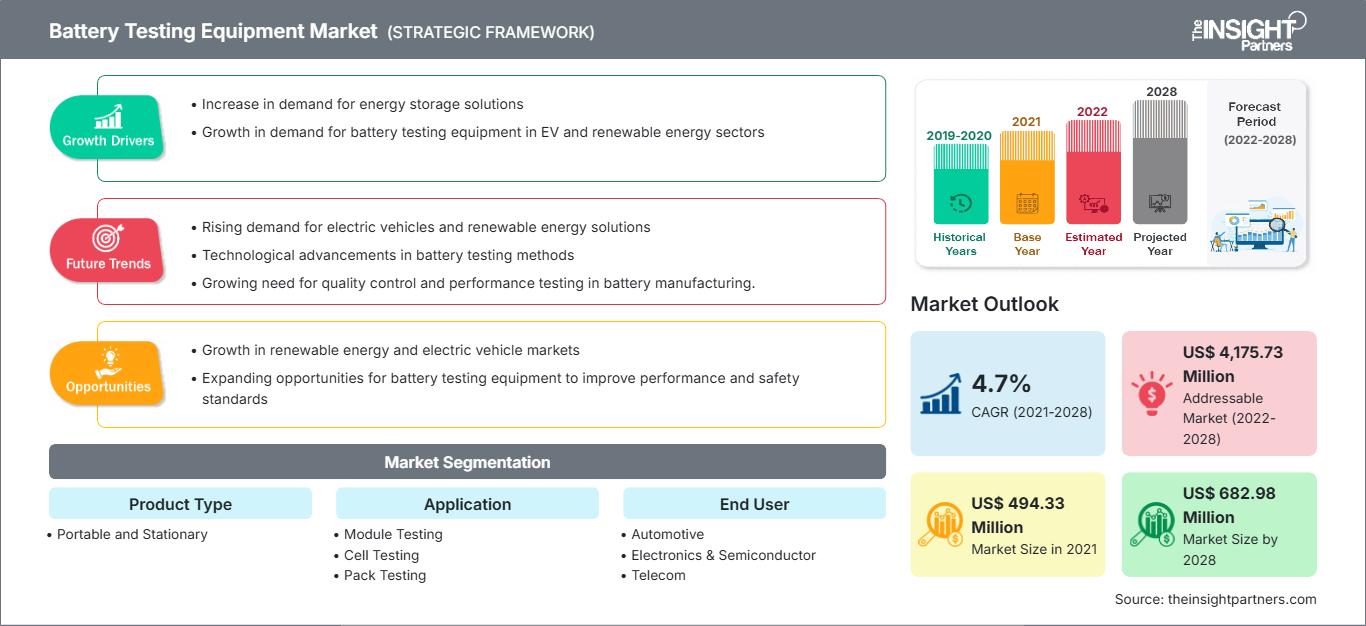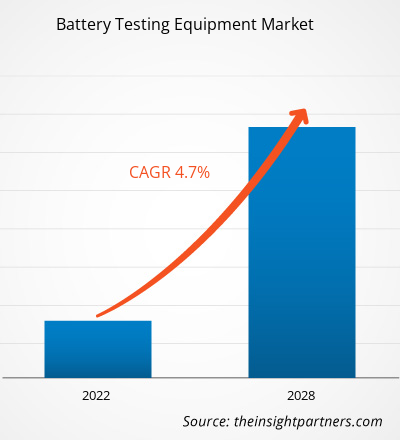Battery Testing Equipment Market Key Players and Forecast by 2028
Historic Data: 2019-2020 | Base Year: 2021 | Forecast Period: 2022-2028Battery Testing Equipment Market Forecast to 2028 - COVID-19 Impact and Global Analysis By Product Type (Portable and Stationary), Application (Module Testing, Cell Testing, and Pack Testing), and End User (Automotive, Electronics & Semiconductor, Telecom, Healthcare, Energy & Utility, and Others)
- Report Date : Apr 2022
- Report Code : TIPRE00004792
- Category : Electronics and Semiconductor
- Status : Published
- Available Report Formats :


- No. of Pages : 177
The battery testing equipment market was valued at US$ 494.33 million in 2021 and is projected to reach US$ 682.98 million by 2028; it is estimated to grow at a CAGR of 4.7% from 2021 to 2028.
Industries such as aerospace and defense, automotive, and healthcare are heavily investing in advanced technologies to strengthen their capabilities with advanced machinery and offer enhanced services to customers. Companies in the US, France, Sweden, the UK, and other countries are developing advanced battery testing equipment for their global customers. The rising procurement of advanced batteries by the US Army is also supporting the market growth. Furthermore, the development of eVTOLs and initiatives taken by governments of countries such as Germany, the UAE, and Singapore for developing urban air mobility infrastructure in these countries are expected to drive the growth of the battery testing equipment market players.
Elevating defense expenditure in countries such as the US, China, and India, and others is expected to drive the growth of the battery testing equipment market in the coming years. Developing countries, such as India, China, and Indonesia, focus on strengthening their military capabilities due to rising clashes across the borders shared with neighboring countries. The expanding manufacturing sectors in countries such as China and India are further propelling the battery testing equipment market growth.
Customize This Report To Suit Your Requirement
You will get customization on any report - free of charge - including parts of this report, or country-level analysis, Excel Data pack, as well as avail great offers and discounts for start-ups & universities
Battery Testing Equipment Market: Strategic Insights

-
Get Top Key Market Trends of this report.This FREE sample will include data analysis, ranging from market trends to estimates and forecasts.
Impact of COVID-19 Pandemic on North America Battery Testing Equipment Market Growth
The US is the most affected country in North America due to COVID-19. Many of the manufacturing facilities were either temporarily shut down or are operating with minimum staff; the supply chain of components and parts is disrupted; these are some of the critical issues faced by the North American manufacturers.
Since the US has a larger number of battery testing equipment, component manufacturers, and industries, the outbreak has severely affected each production and revenue generation. The lower number of manufacturing staff has resulted in lesser production quantity. On the other hand, the limited availability of raw materials and aerospace closing has also impacted the battery testing equipment market in the US. However, the rising military expenditure of the country and the growing development of electric vehicles by companies such as Tesla are expected to provide growth opportunities to the battery testing equipment market players in the near future.
Market Insights – Battery Testing Equipment Market
Growing Demand for Transportation to Drive the
Due to the increasing disposable income of people in developing economies, such as China, India, South Korea, and others, the demand for vehicles has increased. According to the Society of Indian Automobile Manufacturers (SIAM), passenger vehicle sales in India increased by 26.45% from September 2019 to September 2020. Factors such as increasing investments by prominent vehicle manufacturing companies and favorable government norms regarding vehicle manufacturing across Asia Pacific are expected to drive the growth of the battery testing equipment market in the region. Further, initiatives undertaken by the governments of countries such as Vietnam to expand its automotive industry are also expected to drive the battery testing equipment market size.
Product Type-Based Insights
Based on product type, the battery testing equipment market is segmented into portable battery testing equipment and stationary battery testing equipment. The stationary battery testing equipment segment led the battery testing equipment market with a market share of 54.1% in 2020. The stationery battery testing is performed for a capacity test when the battery is new as part of the acceptance test, for impedance testing to establish baseline values for the battery, and to repeat the above testing process within 2 years for the warranty of the battery. The testing process checks the impedance quarterly on valve-regulated lead-acid (VRLA) cells and performs capacity tests at every 25% expected service life.
Application-Based Insights
Based on application, the battery testing equipment market is segmented into module testing, cell testing, and pack testing. The cell testing segment led the market in 2020. The cell stress tests are performed to evaluate the response to electrical, environmental, and mechanical stresses, among others. Cell testing provides a long battery life and simulates complex real-world test profiles. Moreover, cell testers are designed for performing tests on lithium-ion batteries, electrical double-layer capacitors (EDLC), and lithium-ion capacitors (LIC). This is anticipated to boost the battery testing equipment market size.
Based on geography, the battery testing equipment market is segmented into five major regions, namely, North America, Europe, APAC, MEA, and SAM. In 2020, North America held the largest revenue share, followed by Europe and APAC, respectively. The market in APAC is expected to grow at the fastest CAGR of 5.8% from 2020 to 2028. Arbin Instruments, Century Yuasa Batteries Pty Ltd., Chauvin Arnoux, Chroma Systems Solutions, Inc., DV Power, Extech Instruments, Megger, Midtronics, Inc., Storage Battery Systems, LLC, and Xiamen Tmax Battery Equipments Limited are among the key players in the ecosystem that were profiled during this market study.
Battery Testing Equipment Market Regional InsightsThe regional trends and factors influencing the Battery Testing Equipment Market throughout the forecast period have been thoroughly explained by the analysts at The Insight Partners. This section also discusses Battery Testing Equipment Market segments and geography across North America, Europe, Asia Pacific, Middle East and Africa, and South and Central America.
Battery Testing Equipment Market Report Scope
| Report Attribute | Details |
|---|---|
| Market size in 2021 | US$ 494.33 Million |
| Market Size by 2028 | US$ 682.98 Million |
| Global CAGR (2021 - 2028) | 4.7% |
| Historical Data | 2019-2020 |
| Forecast period | 2022-2028 |
| Segments Covered |
By Product Type
|
| Regions and Countries Covered |
North America
|
| Market leaders and key company profiles |
|
Battery Testing Equipment Market Players Density: Understanding Its Impact on Business Dynamics
The Battery Testing Equipment Market is growing rapidly, driven by increasing end-user demand due to factors such as evolving consumer preferences, technological advancements, and greater awareness of the product's benefits. As demand rises, businesses are expanding their offerings, innovating to meet consumer needs, and capitalizing on emerging trends, which further fuels market growth.

- Get the Battery Testing Equipment Market top key players overview
Players operating in the battery testing equipment market are mainly focused on the development of advanced and efficient products and collaborations.
- In 2021, Keysight Technologies, Inc. and Proventia Oy collaborated to improve electric vehicle (EV) battery test solutions.
- In 2021, Chroma launched an E-Scooter fast charging testing system to help CHAdeMO Association check electric vehicle charging interface stimulators. In line with the international growth of the EV industry, it is also going to help define the Protocol Check Sheet for fast charging test standards for two-wheeled EVs.
Frequently Asked Questions
What trends are expected to drive the demand for various battery testing equipment?
Which region is expected to dominate the battery testing equipment market in the forecast period?
Which product type is expected to dominate the market during the forecast period ?
Which component is expected to dominate the market in the forecast period?
What are the reasons behind battery testing equipment market growth?
What are market opportunities for battery testing equipment market?
Naveen is an experienced market research and consulting professional with over 9 years of expertise across custom, syndicated, and consulting projects. Currently serving as Associate Vice President, he has successfully managed stakeholders across the project value chain and has authored over 100 research reports and 30+ consulting assignments. His work spans across industrial and government projects, contributing significantly to client success and data-driven decision-making.
Naveen holds an Engineering degree in Electronics & Communication from VTU, Karnataka, and an MBA in Marketing & Operations from Manipal University. He has been an active IEEE member for 9 years, participating in conferences, technical symposiums, and volunteering at both section and regional levels. Prior to his current role, he worked as an Associate Strategic Consultant at IndustryARC and as an Industrial Server Consultant at Hewlett Packard (HP Global).
- Historical Analysis (2 Years), Base Year, Forecast (7 Years) with CAGR
- PEST and SWOT Analysis
- Market Size Value / Volume - Global, Regional, Country
- Industry and Competitive Landscape
- Excel Dataset
Recent Reports
Related Reports
Testimonials
The Insight Partners' SCADA System Market report is comprehensive, with valuable insights on current trends and future forecasts. The team was highly professional, responsive, and supportive throughout. We are very satisfied and highly recommend their services.
RAN KEDEM Partner, Reali Technologies LTDsI requested a report on a very specific software market and the team produced the report in a few days. The information was very relevant and well presented. I then requested some changes and additions to the report. The team was again very responsive and I got the final report in less than a week.
JEAN-HERVE JENN Chairman, Future AnalyticaWe worked with The Insight Partners for an important market study and forecast. They gave us clear insights into opportunities and risks, which helped shape our plans. Their research was easy to use and based on solid data. It helped us make smart, confident decisions. We highly recommend them.
PIYUSH NAGPAL Sr. Vice President, High Beam GlobalThe Insight Partners delivered insightful, well-structured market research with strong domain expertise. Their team was professional and responsive throughout. The user-friendly website made accessing industry reports seamless. We highly recommend them for reliable, high-quality research services
YUKIHIKO ADACHI CEO, Deep Blue, LLC.This is the first time I have purchased a market report from The Insight Partners.While I was unsure at first, I visited their web site and felt more comfortable to take the risk and purchase a market report.I am completely satisfied with the quality of the report and customer service. I had several questions and comments with the initial report, but after a couple of dialogs over email with their analyst I believe I have a report that I can use as input to our strategic planning process.Thank you so much for taking the extra time and making this a positive experience.I will definitely recommend your service to others and you will be my first call when we need further market data.
JOHN SUZUKI President and Chief Executive Officer, Board Director, BK TechnologiesI wish to appreciate your support and the professionalism you displayed in the course of attending to my request for information regarding to infectious disease IVD market in Nigeria. I appreciate your patience, your guidance, and the fact that you were willing to offer a discount, which eventually made it possible for us to close a deal. I look forward to engaging The Insight Partners in the future, all thanks to the impression you have created in me as a result of this first encounter.
DR CHIJIOKE ONYIA MANAGING DIRECTOR, PineCrest Healthcare Ltd.Reason to Buy
- Informed Decision-Making
- Understanding Market Dynamics
- Competitive Analysis
- Identifying Emerging Markets
- Customer Insights
- Market Forecasts
- Risk Mitigation
- Boosting Operational Efficiency
- Strategic Planning
- Investment Justification
- Tracking Industry Innovations
- Aligning with Regulatory Trends




















 Get Free Sample For
Get Free Sample For